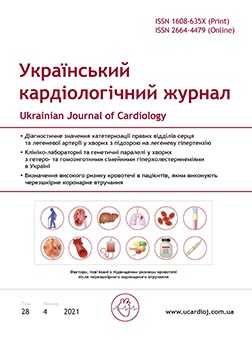Clinical, laboratory and genetic parallels in patients with hetero- and homozygous familial hypercholesterolemia in Ukraine
Main Article Content
Abstract
The aim – clinical, laboratory and genetic parallels of patients with hetero- and homozygous familial hypercholesterolemia (FH) in Ukraine.
Materials and methods. 231 FH patients were included in the Ukrainian FH Registry: 8 children (under 18 years of age) and 223 adult patients (197 heterozygous FH (HeFH) patients, 26 homozygous FH (HoFH) patients, verified according to DLCN criteria). The patients underwent general clinical, laboratory, instrumental examinations and genetic testing.
Results and discussion. Among HeFH patients against the background of early manifestation of atherosclerosis, the male patients were more likely to have coronary heart disease and peripheral atherosclerosis, xanthomatosis and higher DLCN scores against an increase in % obesity and hypertension among HeFH women on the background of significantly lower DLCN. In the HoFH patients despite the inclusion of mostly reproductive aged females in the Registry, it is among women the most severe variants of FH were registered. They were characterized by a predominance of coronary heart disease, MI, xanthomatosis, the need for myocardial revascularization and prosthetic heart valves on the background of higher DLCN scores, cholesterol, LDL-C and ApoB values up to 1.7±0.2 g/L and Lp (a) up to 119.5±31.4 nmol/L. In HoF patients and the most severe variants of the clinical course, who had levels of «statin naive» cholesterol and LDL above 20 mmol/L a more significant increase in these values were found: ApoB average 3.2±1.1 (maximum – 4.72) g/L and Lp (a) to 121.5±41.5 (maximum – 163) nmol/L and reduction of apoA1 level to 0.9±0.1 g/L.
Conclusions. HeFH patients retain gender features of the risk factors profile, which corresponds to the main gender-related trends revealed by the Ukrainian population study with a predominance of coronary heart disease, peripheral atherosclerosis and xanthomatosis on the background of higher scores on DLCN in men. HoFH patients showed a reverse trend, namely among women – the predominance of coronary heart disease, myocardial infarction, xanthomatosis and the need for revascularization on the background of a higher score on DLCN. The cohort of HoFH women revealed the most severe FH cases with LDL-C > 20 mmol/L, which was accompanied in 100 % of cases by early development of coronary heart disease and the need for myocardial revascularization, despite young age (36.5±3.9) and preserved reproductive function. According to HoFH patients genetic testing, pathogenetic mutations were detected in 72.3 % of women and 55.5 % of men (92.3 % in LDLR and 7.7 % in apoB). In the cohort of the most severe patients with LDL and LDL cholesterol > 20 mmol/L, genetic mutations were detected in 100 %
Article Details
Keywords:
References
Митченко Е.И., Мамедов М.Н., Колесник Т.В., Деев А.Д. Современный профиль факторов риска сердечно-сосудистых заболеваний в городской популяции Украины // Укр. кардіол. журн.– 2013.– Додаток 4. Матеріали XIV Національного конгресу кардіологів України.– С. 76–83.
Мітченко О.І., Романов В.Ю., Чулаєвська Н.М., Тімохова К.О. Сімейна гіперхолестеринемія: етіопатогенез, діагностика, лікування та стан проблеми в Україні // Укр. кардіол. журн.– 2019.– № 4.– С. 23–31. doi: 10.31928/1608-635X-2019.4.2331.
Beheshti S.O., Madsen C.M., Varbo A. et al. Worldwide Prevalence of Familial Hypercholesterolemia. Meta-Analyses of 11 Million Subjects // J. Amer. Coll. Cardiololy.– 2020.– Vol. 75 (20).– P. 2553–2566. doi: 10.1016/j.jacc.2020.03.057.
Cuchel M., Bruckert E., Ginsberg H.N. et al. Homozygous familial hypercholesterolaemia: New insights and guidance for clinicians to improve detection and clinical management. A position paper fromthe Consensus Panel on Familial Hypercholesterolaemia of the European Atherosclerosis Society // Eur. Heart J.– 2014.– Vol. 35 (32).– P. 2146–2157. doi: 10.1093/eurheartj/ehu274.
Cuchel M., Meagher E.A., Theron H.D.T. et al. Efficacy and safety of a microsomal triglyceride transfer protein inhibitor in patients with homozygous familial hypercholesterolaemia: A single-arm, open-label, phase 3 study // Lancet.– 2013.– Vol. 381 (9860).– P. 40–46. doi: 10.1016/S0140-6736(12)61731-0.
Doi T., Kataoka Y., Asaumi Y. et al. Sex-related differences in clinical characteristics, low-density lipoprotein cholesterol control and cardiovascular outcomes in familial hypercholesterolemia // Eur. Heart J.– 2017.– Vol. 38, Suppl. 1, ehx 501.– P. 631. doi: 10.1093/eurheartj/ehx501.P631.
Mach F., Baigent C., Catapano A.L. et al. ESC Scientific Document Group, 2019 ESC/EAS Guidelines for the management of dyslipidaemias: lipid modification to reduce cardiovascular risk: The Task Force for the management of dyslipidaemias of the European Society of Cardiology (ESC) and European Atherosclerosis Society (EAS) // Eur. Heart J.– 2020.– Vol. 41 (1).– P. 111–188. doi: 10.1093/eurheartj/ehz455.
Nordestgaard B.G., Chapman M.J., Humphries S.E. et al. Familial hypercholesterolaemia is underdiagnosed and undertreated in the general population: guidance for clinicians to prevent coronary heart disease: Consensus Statement of the European Atherosclerosis Society // Eur. Heart J.– 2013.– Vol. 34, Issue 45, 1.– P. 3478–3490. doi: 10.1093/eurheartj/eht273.
Raal F.J., Rosenson R.S., Reeskamp L.F. et al. Evinacumab for homozygous familial hypercholesterolemia // New Engl. J. Med.– 2020.– Vol. 383 (8).– P. 711–720. doi: 10.1056/NEJMoa2004215.
Sjouke B., Kusters D.M., Kindt I. et al. Homozygous autosomal dominant hypercholesterolaemia in the Netherlands: Prevalence, genotype-phenotype relationship, and clinical outcome // Eur. Heart J.– 2015.– Vol. 36 (9).– P. 560–565. doi: 10.1093/eurheartj/ehu058.
Sharifi M., Syngal N., Jain A. et al. Gender differences in characteristics of the patients with familial hypercholesterolemia // Atherosclerosis.– 2019.– Vol. 287.– P. E 217. doi: 10.1016/j.atherosclerosis.2019.06.660.
Vallejo-Vaz A.J., Dharmayat K., Stevens C. et al. Characteristics of adults with heterozygous familial hypercholesterolaemia stratified by gender: Preliminary analysis from the EAS FHSC Global Registry on over 36,000 cases of familial hypercholesterolaemia. Abstract 1356 // Atherosclerosis.– 2020.– Vol. 315.– E13. doi: 10.1016/j.atherosclerosis.2020.10.052.


